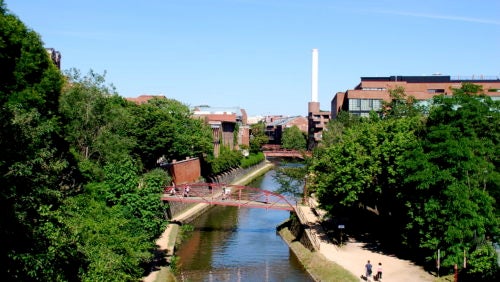Preservation and Planning in the District: Eco-Friendly Features Contribute to Special Merit under D.C. Historic Preservation Law
April 26, 2019 by Ilse P. Johnson

Chesapeake & Ohio Canal in Georgetown
Whether a project is one of “special merit” is often a “tug of war” among preservationists, developers, neighbors, and the community-at-large. One way to tug towards special merit status is to incorporate eco-friendly features into the new development.
In the District of Columbia, one in five properties is protected by local historic designation laws, and one in four property owners own historically designated properties.[1] Owners of these properties, if they have ever tried to make any changes—whether alterations, demolitions, or subdivisions—know that the historic preservation law[2] that protects their properties is tough.[3] Often, if they wish to make changes, they must show that their alteration, demolition, or subdivision is “necessary in the public interest”[4]—i.e., necessary to construct a project that is of “special merit.”[5]
Eco-friendly property owners or any developers hoping to build a project of “special merit,” then, should take note of recent projects whose eco-friendly features contributed to them being of “special merit.”
In Georgetown 29K Acquisitions LLC,[6] the Mayor’s Agent[7] concluded that the “conversion of a polluted and inaccessible coal yard to a well-designed public park, provided to and maintained for the residents of the District at no cost is a significant community benefit.” The park advanced key elements of the District’s Comprehensive Plan[8] and fulfilled them beyond what was required.[9] The Mayor’s Agent found “exceptional” not only that this new park would be kept open to the public at the expense of a private property but also that the new park, through the use of a planned bridge, would connect this park with neighboring Rock Creek Park, the C & O Towpath, and the Georgetown Waterfront Park, providing an important amenity to all visitors.[10]
In Vision McMillan,[11] the Mayor’s Agent included the project’s recreation and open space as part of the special merit package. Here, the Comprehensive Plan stressed that the Mid-City area was in “dire need” of parks which “provide for both active and passive recreational uses” and “adhere to high standards of landscape design, accessibility, and security.” Because the project would contain more than six-acres of green space, a 17,500-square foot community center, a twenty-five-meter swimming pool, a playground and “sprayground,” amphitheater, pond, and a walking museum and another one-acre park would be set aside for a “healing garden,”[12] the Mayor’s Agent confirmed that the project would add “a substantial amenity.”[13] Further, the Mayor’s Agent noted the site plan’s “scrupulously environmentally sustainable design, including meeting LEED-Neighborhood Development Standards at the Gold level or equivalent for the overall project, pervious pavement, bioswales, and rain gardens” were specific features of land planning that contributed to the project’s special merit.[14]
With urban development on the rise, D.C. is likely to see a rise in proposals for projects of “special merit.” Developers will claim a historic property’s demolition, subdivision, or alteration is necessary to construct their project of “special merit.” This question of whether a project is “special merit” is often a “tug of war” among preservationists, developers, neighbors, and the community-at-large.[15] In fact, the Vision McMillan case is back with the D.C. Court of Appeals for the second time, with parties anxiously awaiting the court’s decision.[16] If anything is clear from these cases, however, it is that incorporating environmental and sustainability concepts and tying them with key elements in the District’s Comprehensive Plan will contribute to a project’s special merit package. They may not suffice on their own, but they will tug towards special merit.
[1] 2020 District of Columbia Historic Preservation Plan: Preserving for Progress 46 (D.C. Hist. Preservation Off. Jan. 2018), https://planning.dc.gov/sites/default/files/dc/sites/op/publication/attachments/2020%20DC%20Historic%20Preservation%20Plan.pdf; see also Payton Chung, DC has more historic buildings than Boston, Chicago, and Philadelphia combined. Why?, Greater Greater Wash., Jan. 5, 2018, https://ggwash.org/view/65911/why-dc-has-so-many-historic-buildings.
[2] Historic Landmark and Historic District Protection Act of 1978, D.C. Code § 6-1104(e), -1105(f), -1106(e) (D.C. 2019), at https://code.dccouncil.us/dc/council/code/titles/6/chapters/11/.
[3] Anile H. Oman, New Law Protects District Landmarks, Wash. Post, Mar. 8, 1979, at D.C. 1 (referring to the Historic Landmark and Historic District Protection Act of 1978 as “tough law protecting historic buildings in the District”).
[4] D.C. Code § 6-1104(e), -1105(f), -1106(e) (D.C. 2019), at https://code.dccouncil.us/dc/council/code/titles/6/chapters/11/.
[5] D.C. Code § 6-1102(10).
[6] HPA No. 17-263, 17-545, 17-633 (January 11, 2019), at 6.
[7] D.C. Mayor’s Agent, A Subject Matter Summary for “Mayor’s Agent—General revised”, Geo. L. Libr., https://repository.library.georgetown.edu/handle/10822/761580.
[8] Office of Planning, Comprehensive Plan, DC.gov, at https://planning.dc.gov/page/comprehensive-plan.
[9] Georgetown 29K Acquisitions LLC, HPA No. 17-263, 17-545, 17-633 (January 11, 2019), at 4, 6.
[10] Id.
[11] HPA No. 14-393, 15-133 (Apr. 3, 2018), at 15.
[12] Id.
[13] Id.
[14] Id. at 16.
[15] Carolyn Brown, Attorney, Donohue & Stearns, PLC, “Historic Preservation Law Panel”, Spring 2019 Symposium: The Role of Environmental, Land Use, and Housing Law in Washington, D.C. Property Development, The Georgetown Environmental Law Society et al. (Apr. 16, 2019) (notes on file with author).
[16] “McMillan Park News Update,” Friends of McMillan Park (Mar. 17, 2019), http://friendsofmcmillan.org/.

